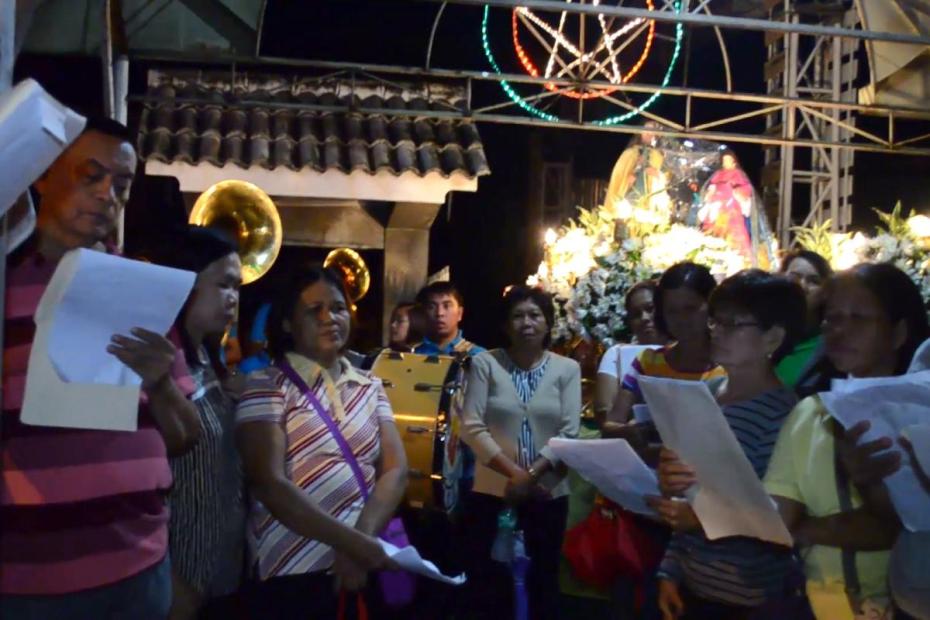Christmas Eve, often known by its Spanish name, Noche Buena, begins for many Filipino Catholics early in the morning with a pre-dawn Simbang Gabi Mass. By nighttime, the celebration that has been under way for some time reaches its peak. The primary Christmas Mass for most Filipinos, the Misa de Gallo, takes place late in the evening. Mass is preceded by, or includes, a Panunuluyan reenactment, and is followed by public and family festivities that run deep into the night.
Panunuluyan
Panunuluyan, a traditional Filipino reenactment of Joseph and Mary’s search for suitable place for Mary to give birth to Jesus, is a key part of most Filipino Catholics’ Christmas Eve celebrations, whether in the streets or at Mass.
In both street and parish celebrations, the Panunuluyan is adapted to the local landscape, and the story is brought into the present moment, so that the families involved always see themselves as the people who ritually fail to give Joseph and Mary a place to bring Jesus into the world. Often the actors wear colorful biblical costumes, or at least Philippine versions of biblical dress. Families request that the Panunuluyan visit their homes. Mary and Joseph walk the neighborhoods and knock at the doorstep of these homes to beg for shelter, but each in turn rejects Joseph and Mary, until they find a stable where animals are being fed and where Mary finally gave birth to “baby Jesus.”
One traditional form of Panunuluyan entails a procession of devotees using a flower- and light-adorned carozza, or float, carrying statues of Joseph and Mary. One video on this page shows how the parishioners of St. Joseph the Worker Parish in Panasahan, Malolos, Bulacan, bring a carozza from house to house. In recent years, a larger number of homeowners have asked to be stations where Joseph and Mary would stop to beg along the route. A brass band accompanies the entire procession. A group of men sings the lines of Joseph, and a group of women sings the lines of Mary. Together, the men and women sing the lines of the homeowners. Mary and Joseph sing out their plea in front of different houses to beg for a shelter, but in turn the homeowners call out their rejection. After the last house is reached, the procession goes back to the church, which has a stable to represent where Mary and Joseph finally found shelter. The birth of Jesus in the church is announced by the ringing of church bells.
This video from St. Joseph the Worker Parish in Panasahan, Malolos, Bulacan, on December 24, 2014 shows how parishioners bring a carozza, or float, carrying Joseph and Mary statues from house to house to re-enact their search for a suitable place for Mary to give birth to Jesus. Videography by Maricel Eballo and Angelo Fernandez.
Misa de Gallo, 'Midnight' Mass
The primary liturgical celebration for Filipinos is the Misa de Gallo, a “Midnight” Mass that takes place at night but is usually finished by midnight. A Panunuluyan is often a highlight of that Mass. The second video on this page from Santa Rita Parish in Pampanga shows a version of the Panunuluyan as it is incorporated into the liturgy, bringing the story up to the moment when the Christ child has been born and is worshipped by the magi. In this video, children dressed as angels are representatives of all the barangays1 in Santa Rita Parish.
Panunuluyan is incorporated into the liturgy at Santa Rita Parish in Pampanga, bringing the story up to the moment when the Christ child has been born and is worshipped by the magi.
In Siniloan, Quezon, local residents are tapped as actors to dramatize the story from the angel’s declaration to Mary that she will bear the Messiah, through the birth of Jesus in an animal stable. At San Pedro Cathedral, Davao City, a family from the parish is tasked to “bring baby Jesus” to an empty baby crib where the statue of Mary and Joseph are standing at the miniature belen, or stable, at the altar. Filipinos often talk about this as the highlight of the nighttime Mass.
After Mass, family members return home together by midnight to celebrate as a family the coming of the Jesus. Carousing, revelry and feasting are the order of the night. At midnight people shout and jump in the streets, have fun in their homes and yards and savor the moment. In Cebu, fireworks light the skies. Families enjoy a grand, traditional Noche Buena dinner that should outdo even the food and celebration that preceded it. The traditional menu consists of chicken (roasted/fried/turbo, tinola, etc.), pork (lechon, adobo, etc.), beef (stew, caldereta, etc.), loaf bread or pan de sal or any other bread, coffee, juice, various kinds of rice cake delicacies, pasta pancit, fruit and vegetable salads, and fresh fruits. Chicken, bread, coffee, spaghetti and rice straw (pancit) are the commonest foods in almost every Filipino home during Christmas as well as on all the important occasions in their lives.
After the Noche Buena meal, a traditional “opening of the gifts” follows, when members of the family take turns giving gifts to one another. People often stay up all night and young people visit their friends.
Christmas day is quieter, when members of the family visit their elders, godfathers, godmothers, neighbors, friends, and relatives to pay respects, meet and greet, and to give and to receive Christmas presents.
- 1Barangays are neighborhood entities that have their own elected officials.
